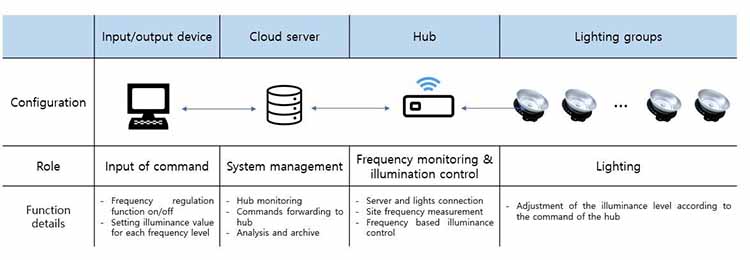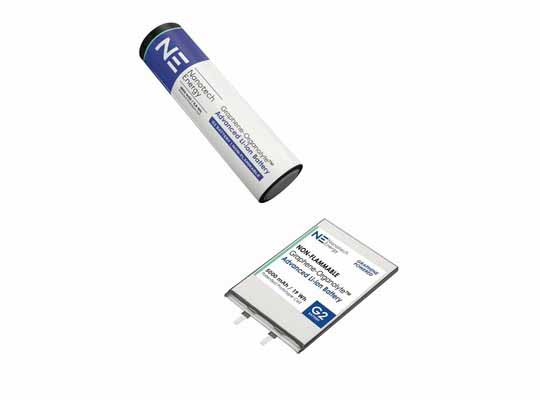- The world’s first innovative IoT smart lighting system that connects more than 2,000 devices into one scalable mesh network and automatically responds to electric grid’s frequency fluctuations in real time has been launched.
- The Korea Power Exchange, a public corporation of the Korean government, signed an MOU with Merlot Lab on November 25, 2021 to demonstrate frequency regulation using 4,300 IoT smart lights installed at Jungbu Complex Logistics Terminal of CJ Logistics, the largest logistics company in Korea. There are large and growing interests from major domestic and overseas energy companies for demonstration result of frequency regulation using IoT smart lighting system.
SEOUL, South Korea — Renewable energy transformation is accelerating all over the world. However, the rising penetration of renewable energy resources such as wind and photovoltaic in power systems presented significant problems for frequency regulation due to their intermittent nature – its output fluctuates wildly throughout the day, and depending on the weather across the many renewable energy sites. A common concern of grid operators around the world has been the problems of volatility in renewable energy, and ways to handle this challenge effectively.

In a move to find better ways to resolve the variation in frequency caused by mismatch between supply and demand of electricity, the grid operators are turning their attention to demand side management of the equation, where demand is adjusted in real time in accordance with power supply through new frequency regulation tools such as Fast DR (Demand Response).
Fast DR is designed to reduce electricity demand in near real time in response to grid changes, such as unexpected spikes in energy use, when electricity generation may not be sufficient to meet peak load, or sudden drops in wind or solar generation.
In advanced countries such as the US and Germany, Fast DR is used as a fast-acting resource for countering output volatility of renewables. In Korea, in line with expansion of renewables, the energy policy paradigm shifted from focus on building sufficient generation capacity to demand side management through energy flexibility and efficiency. The role of Fast DR is fast increasing.
Against this backdrop, the Korea Power Exchange, a government public corporation responsible for power supply and demand management in Korea, signed an MOU with Merlot Lab (CEO So-bong Shin) who developed an IoT smart lighting system as a new frequency control resource to solve the problem of supply volatility of renewable energy, and announced that they would start the demonstration of frequency regulation using IoT smart lighting system on November 25, 2021.
During the joint demonstration period until August next year, the Korea Power Exchange will formulate the Fast DR frequency regulation operation standards and guidelines required for the power system and verify with the demonstration results. Merlot Lab will participate in the demonstration of automatic illuminance adjustment of smart lighting in accordance to frequency regulation operation by using its 4,300 connected lights installed in the Jungbu Complex Logistics Terminal of CJ Logistics.
The IoT smart lighting developed by Merlot Lab is a major breakthrough in smart connected lighting technology as it is a truly scalable, wireless mesh network that can control thousands of light nodes from a single hub, where each and groups of lights can be controlled at 1% illuminance level increment, making it an ideal solution for various frequency regulation demonstrations.
Despite great merits and potentials, smart connected lightings could not be readily implemented so far as they suffered high installation costs and reliability issues. Merlot Lab’s IoT smart lighting system can be implemented by simple drop-in replacement of exiting conventional light with Merlot Lab’s IoT light. Unlike other competing smart light solutions, there is no additional cabling, and networking hardware installation required thanks to Merlot Lab’s scalable and reliable 100% wireless network solution.
As gradual light illuminance level change of 20~30% from the peak illuminance level does not lead to noticeable perceived illumination level change to human eyes, nor affect work productivity, Merlot Lab’s IoT smart lighting can automatically reduce energy load by adjusting light illuminance level by 20~30% as it responds to event signals sent by the grid, making it a great demand-side resources for frequency control. The mesh network implemented by Merlot Lab can bring a revolutionary change in smart lighting.
- The mesh network implemented by Merlot Lab is the world’s first technology that connects thousands of devices in a single mesh network. This is what engineers in short-range wireless communication technology has been trying to achieve over the past 20 years.
Companies who installed Merlot Lab’s IoT smart lighting system will be able to earn financial benefits through participation in the ancillary service market in the power system. Furthermore, the participants can contribute to ESG value of achieving carbon neutrality by supplying the much-needed flexible resources to the power system, contributing greatly to resolving the instability of power supply caused by the expansion of renewable power generation.
An official from the Korea Power Exchange said, “The amount of electricity currently used for lighting accounts for about 20% of the total electricity consumption in Korea. When the role of frequency regulation of IoT smart lighting systems is successfully demonstrated, it is expected to greatly contribute to resolving the problem of instability in the power system from the increase in the proportion of renewable energy.”
When the IoT smart lighting system is installed widely in the future, the frequency regulation mechanism can change from current simple power cut-off method in case of an emergency to continuous and automatic demand control with large number of smart lights which reduce energy load by 20~30% when power is in shortage, and raise to 100% brightness when power supply is in excess.
As large-scale lighting can be expected to take the role of frequency control by continuously and flexibly adjusting the power supply and demand balance, there are large and growing interest from major domestic and overseas energy companies for demonstration of frequency regulation using IoT smart lighting system.













